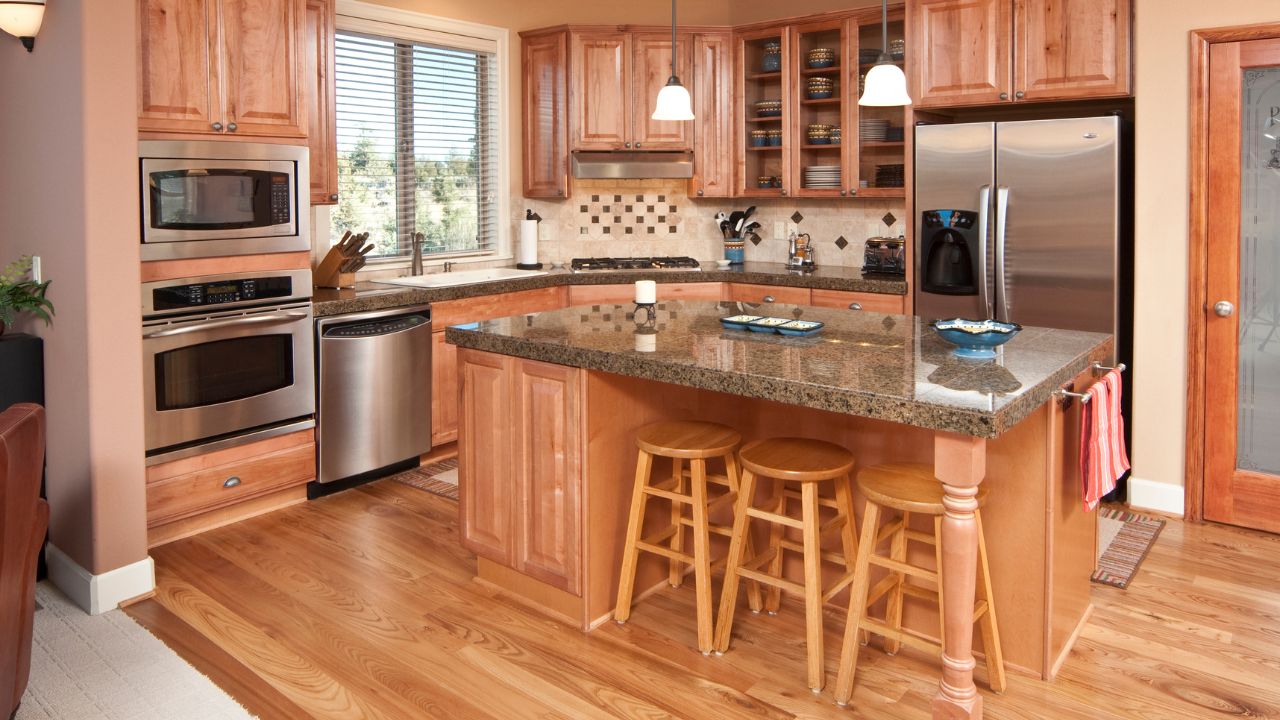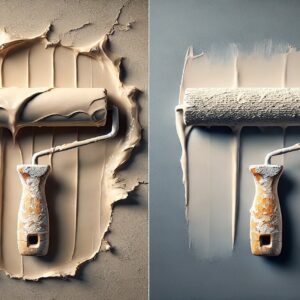The devil is in the details when crafting a truly exquisite living space. One detail that can make a world of difference is the seamless coordination of wood floors, cabinets, and furniture. It’s no secret that wood brings warmth and character to any room, but achieving the perfect balance between these elements can be daunting. Fear not, for we will unravel the art of harmonizing your wood surfaces in this guide. Whether you’re renovating your kitchen, revamping your living room, or just looking to refresh your home’s aesthetic, these expert tips will help you master the art of matching wood floors to cabinets and furniture. Get ready to transform your space into a symphony of style and sophistication.
Start with a Unifying Theme
Before diving into the specifics of wood types and colors, it’s essential to establish a unifying theme for your home’s interior design. This theme will serve as a foundation for all your design decisions, including your choice of wood floors, cabinets, and furniture.
Consider the overall style you want to achieve. Are you aiming for a modern, minimalist look or prefer a cozy, rustic ambiance? You may want a classic, timeless feel or a trendy, eclectic vibe. Determining your theme will help narrow your options and guide you in making cohesive choices.

Create Contrast for Interest
While a unified theme is crucial, creating visual interest in your space is also essential. One way to achieve this is through contrast. If your cabinets and furniture match your wood floors too closely, your room can feel more exciting and exciting. To avoid this, aim for some contrast in wood tones.
For instance, consider lighter-colored cabinets and furniture if you have dark wood floors. This contrast will make each element stand out and add depth to the room. Conversely, darker cabinets and furniture can create a striking visual impact if your floors are light.
Consider the Undertones
Wood comes in a wide range of colors, and subtle undertones can significantly impact how different wood elements in a room interact. Undertones are the underlying colors beneath the surface of the wood. These undertones can be warm (reddish or yellowish) or cool (grayish or bluish).
Pay attention to these undertones when matching wood floors to cabinets and furniture. If your wood floors have warm undertones, choosing cabinets and furniture with similar warm undertones is generally best to create harmony. The same principle applies to cool undertones. Mixing warm and cool undertones can create a clash that disrupts the overall aesthetic.
Balance Light and Dark Elements
A balanced look in your space creates a visually appealing interior. Consider the distribution of light and dark wood elements in your room to strike this balance.
If your wood floors are dark, balance them with lighter cabinets and furniture to prevent the space from feeling too heavy or closed in. Conversely, if your floors are soft, darker cabinets and furniture can anchor the room and add a sense of depth.
Embrace Natural Variations
One of the charms of working with is its natural variations in color and grain patterns. Instead of trying to achieve a perfectly uniform look, consider embracing these variations as part of the beauty of wood. Incorporate different species or stains that complement each other, even if they are not an exact match. This can add character and interest to your space, creating a more organic and inviting feel.
Sample and Test
Before committing to a particular combination of wood floors, cabinets, and furniture, it’s essential to sample and test your choices in your actual space. Lighting conditions, wall colors, and the size of your room can all influence how wood tones appear.
Obtain samples of your chosen materials and place them together in the room where they will be installed. Assess how they look in different lighting throughout the day. This will help you make an informed decision and avoid unpleasant surprises once everything is installed.
Incorporate Other Materials
Wood doesn’t have to be the sole focus of your interior design. Other materials like stone, tile, or metal can add depth and contrast to your space. For example, consider adding light-colored stone countertops or stainless steel appliances to break up the monotony if you have dark wood floors and cabinets.
Combining wood with other materials can create a visually appealing interplay of textures and colors, enhancing the overall aesthetics of your home.
Consult a Professional
If you find the process of matching wood floors to cabinets and furniture overwhelming, don’t hesitate to seek the advice of a professional interior designer. They have the expertise to help you select the perfect combination of materials and colors to achieve your desired look.
Interior designers can also provide insights into the latest design trends and innovative ways to blend different wood elements in your space. Their experience can save you time, money, and potential design headaches.
Keep Longevity in Mind
While it’s essential to consider your current design preferences, it’s equally important to consider your long-term durability and style choices. Wood floors, cabinets, and furniture are significant investments in your home; you’ll want them to remain visually appealing for years. opts for timeless styles and finishes that won’t quickly go out of fashion. This way, you can enjoy your well-coordinated wood elements for many years without constantly updating your interior.
Find Neutral Hardwood Floor Colors
The key is to strike a harmonious balance between the warmth and richness of the wood, creating a space that exudes elegance and timelessness. One of the top choices for this task is opting for neutral hardwood floor colors. These shades, which range from soft beiges to gentle grays, offer a versatile backdrop that complements various cabinet finishes. The beauty of neutral tones lies in their ability to seamlessly blend with the existing elements in your kitchen, allowing your cabinetry to take center stage.
Whether your cabinets are crafted from oak, cherry, or walnut, a neutral hardwood floor provides a neutral canvas that enhances the overall aesthetic of your kitchen. This choice not only ensures visual cohesion but also creates a serene atmosphere that’s perfect for cooking, dining, and entertaining. So, when faced with the delightful yet sometimes daunting task of coordinating floors with wood cabinets, remember that neutrals can be your best ally in achieving a timeless and sophisticated kitchen design.
Don’t Pick the Exact Same Shade
Pick a different shade. While it might seem like matching everything is the way to go, this can create a more varied aesthetic. Instead, opt for complementary tones and textures that bring out the best in your flooring and cabinetry. For instance, if you have dark cabinets, consider lighter or contrasting wood floors to add depth and visual interest to your space. Conversely, a darker or subtly different wood floor can create a harmonious yet distinctive look if you have light cabinets. This play of contrast enhances the visual appeal of your kitchen and showcases each element’s unique beauty. So, remember, when harmonizing elements in your home, a little contrast can go a long way in creating a captivating and well-balanced design.
Add Flair with Smaller Décor
One such detail that should never be underestimated is the power of more minor décor elements. Whether you’re revamping your kitchen or refurbishing your living room, adding flair with smaller décor can transform the entire ambiance of your space.
Take, for example, the art of coordinating wood floors with cabinets. This seemingly minor decision can have a profound effect on the overall aesthetics of a room. Matching the wood tones of your cabinetry with your flooring creates a harmonious visual flow and imparts a sense of unity and sophistication. It’s a subtle yet effective way to tie the elements of a room together, providing a seamless and balanced look that exudes elegance.
So, when pondering the finer details of your next design project, don’t underestimate the power of these smaller décor choices. They might be the missing piece that takes your space from ordinary to extraordinary.
Dark Wood Furniture with Dark Wood Floors
Creating a harmonious interior space often revolves around thoughtful design choices, and one pairing that never fails to impress is the coordination of dark furniture with dark wood floors. This dynamic duo brings a sense of timeless elegance and depth to any room. When your dark cabinets or furniture seamlessly align with the rich tones of your flooring, it establishes a visual unity that exudes warmth and sophistication.
The key lies in balancing the shades – opting for furniture and cabinetry that share a similar undertone with the flooring, whether deep espresso or a rich mahogany hue. This unity not only lends a feeling of cohesiveness but also allows for creating intriguing contrasts through the interplay of textures and colors. Whether you envision a classic, traditional ambiance or a more modern and daring aesthetic, the artful combination of dark wood elements can transform a space into a haven of refined style.












Commented Posts